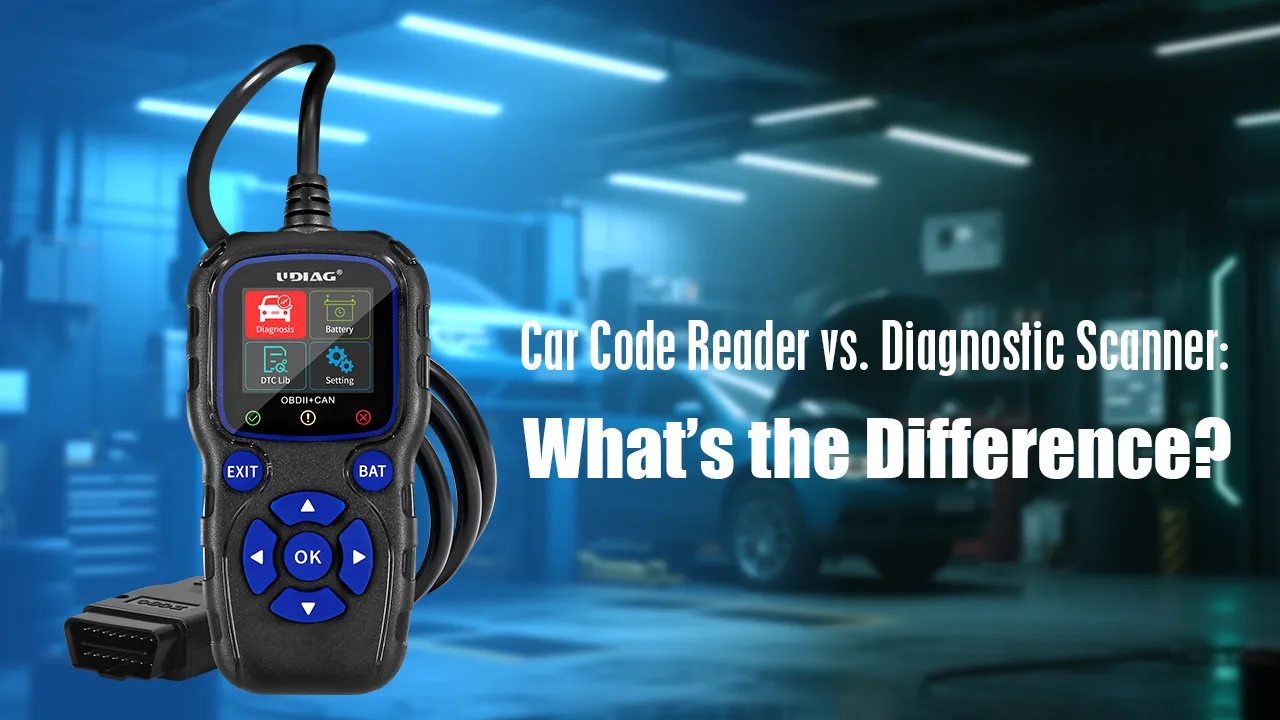Car Code Reader vs. Diagnostic Scanner: What’s the Difference
2025-11-21 by UDIAG

Introduction:
When vehicle repairs rely increasingly on electronics and complex control units, choosing the right diagnostic tool becomes essential for workshop efficiency. Many technicians and buyers often compare a car code reader with a professional diagnostic scanner, yet the two serve very different purposes. Understanding these differences helps workshops, distributors, and technicians choose the tool that best supports their daily workflow.
What Is a Car Code Reader?
A car code reader is a basic diagnostic tool that retrieves and clears Diagnostic Trouble Codes from the engine control unit. It focuses primarily on OBDII emissions-related systems, delivering simple data for quick checks. Code readers are ideal for fundamental tasks such as:
- Reading and erasing engine fault codes
- Checking the status of the MIL
- Viewing basic live data such as coolant temperature or RPM
- Performing simple monitors and I/M readiness tests
Since a code reader works only with standard OBDII protocols, its functions are limited. It does not access ABS, SRS, TPMS, transmission, or advanced modules. For workshops requiring rapid fault identification without deep analysis, code readers offer a low-cost and convenient option.
What Is a Professional Diagnostic Scanner?
A professional diagnostic scanner is a more advanced tool designed for comprehensive vehicle system analysis. It often features a tablet-style interface, powerful processors, manufacturer-specific data, and wide vehicle coverage. Typical capabilities include:
- Full-system scanning for ABS, SRS, TPMS, transmission, BCM, and more
- Live data in graphical form
- Bi-directional control tests
- Actuation tests
- Adaptations and coding functions
- Service resets such as oil, EPB, DPF, BMS, SAS
- Advanced diagnostics with freeze-frame data and fault guidance
This wider functionality makes diagnostic scanners essential for medium to large workshops, diagnostic technicians, and repair centers that require deeper insight into vehicle systems.
Functionality Comparison: Code Reader vs Diagnostic Scanner
1. System Coverage
-
Car Code Reader: Limited to engine and emissions systems.
-
Diagnostic Scanner: Full vehicle system coverage across multiple modules.
A code reader suits quick inspections, while a scanner delivers complete diagnostics for complex vehicles.
2. Depth of Data
-
Car Code Reader: Shows basic live data streams.
-
Diagnostic Scanner: Provides extensive live data, customization, graphing, comparison, and advanced freeze-frame records.
This difference determines how accurately a technician can pinpoint faults.
3. Special Functions
-
Car Code Reader: No bi-directional tests or service reset functions.
-
Diagnostic Scanner: Supports adaptations, resets, calibration, and actuation tests for deeper troubleshooting.
4. Vehicle Coverage
-
Car Code Reader: Works on standard OBDII-compliant vehicles.
-
Diagnostic Scanner: Supports OBDII, manufacturer-specific protocols, and often includes special functions for multiple brands.
5. Ease of Use
-
Car Code Reader: Extremely simple, plug-and-play, and ideal for quick fault checks.
-
Diagnostic Scanner: Requires more operational knowledge but offers complete diagnostic capabilities.
6. Cost Difference
This is one of the most significant differences:
-
Car Code Reader: Affordable, typically ranging from entry-level consumer pricing to low workshop costs.
-
Diagnostic Scanner: Significantly more expensive due to hardware performance, software development, and broader coverage.
Workshops often keep both: a low-cost code reader for quick checks and a high-end scanner for full diagnostics.
Which Tool Should You Choose?
The right choice depends on your workshop needs.
Choose a car code reader if you need:
- Basic diagnostic information
- Quick engine fault checks
- A portable and low-cost solution
- A simple tool for frontline technicians or sales staff testing vehicles
Choose a diagnostic scanner if you need:
- Complete system analysis
- Advanced troubleshooting capabilities
- Service reset and calibration functions
- Faster, more accurate fault location for modern vehicles
Most professional workshops rely on a powerful scanner while keeping a code reader available for rapid pre-checks.
FAQs About Car Code Readers
Q: Can a car code reader diagnose ABS or airbag problems?
A: No, most code readers can only access the engine system. ABS, SRS, and TPMS require a professional diagnostic scanner.
Q: Is a car code reader accurate?
A: Yes, it accurately retrieves engine-related fault codes, but it does not provide advanced analysis or coverage beyond OBDII systems.
Q: Why is a diagnostic scanner more expensive?
A: It offers full-system diagnostics, bi-directional tests, adaptations, service reset functions, and brand-specific data, which require advanced software and hardware.
Q: Do workshops need both tools?
A: Many workshops use a code reader for fast inspections and a full diagnostic scanner for detailed troubleshooting.


